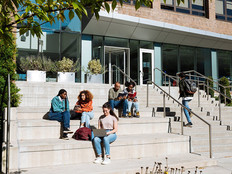Higher Ed Expands Reach Through Video Conferencing
When Louisiana Delta Community College (LDCC) merged with three different regional technical colleges between 2010 and 2012, the university found itself spread across eight campuses statewide, with too many students to teach and not enough teachers or classrooms to accommodate them.
The technology team had a solution in mind: video conferencing. Not the outmoded, difficult-to-use and less reliable systems of times past, but something that would allow instructors to walk in, turn on and get straight to work teaching and interacting with onsite and remote students.
“We have a small technical staff at our college, so it had to be user-friendly,” says Bruce Hemphill, an information systems and database analyst at the school. “We couldn’t be everywhere at the same time.”
The technology team’s new Lifesize 220 room-based video conferencing system — implemented at four LDCC campuses — will soon be in place at all other campus sites. The solution includes interactive cameras and microphones, large-screen HD monitors, scheduling software and recording capability along with the ability to integrate seamlessly with learning management solutions, making for easy content sharing and collaboration.
Sharon Bowman, an associate professor of English and LDCC’s e-learning coordinator, calls the setup simply “a gift from heaven.”
“This is just so perfect for our remote students who still need a personal touch, that real-time interaction with an instructor and with their fellow students,” she says. “It’s been nothing but positive.”
Blurred Lines
LDCC couldn’t have accomplished its remote learning initiative five years ago, but in recent years technology such as video conferencing and telepresence took a quantum leap in quality, says Steve Duplessie, founder of and senior analyst at Enterprise Strategy Group.
“The availability of WAN optimization and compression technologies have allowed for way more data and video to travel through a much smaller pipe,” he says. “As soon as that happened, it literally opened up a world of collaboration.”
Percentage of higher ed faculty and K–12 teachers who agree that student engagement is the greatest factor driving adoption of video-based learning
SOURCE: Center for Digital Education, “Video-Based Learning Solutions in K–12 and HED,” June 2013
The advances blur the lines between once one-dimensional collaboration tools. Today, institutions can obtain video collaboration and content sharing capabilities from any of those solutions at a variety of price points, at varying levels of quality and technical complexity, from Google Hangouts to fully immersive, room-based telepresence solutions. Some even come in at under $1,000, eliminating price as an excuse, Duplessie says.
For instance, two years ago Wake Forest University gave its entire student community a license for the Cisco Systems WebEx solution suite, a web conferencing solution. As expected, the technology inspired students and faculty to hold spontaneous meetings along with connecting offsite students. Other benefits surprised the team, says Rick Matthews, Wake Forest’s CIO and associate provost for technology and information systems.
For example, course participants can now use WebEx within a single classroom to project content onto a monitor and share it with the rest of the class, negating the need for expensive display switching technology.
“That sounds trivial, but with live WebEx, you can save hundreds of thousands of dollars on hardware and also end up with a highly flexible classroom where students can solve problems as a group and share and collaborate without any need to reconfigure the classroom or deal with a bunch of wires,” Matthews says.
On the other end of the technology spectrum, the University of Pennsylvania’s Wharton School of Business invested in a high-end, room-based Cisco Telepresence system to enable bicoastal classes for students located at both the main Philadelphia campus and a satellite campus in San Francisco.
A floor-to-ceiling screen at the front of each classroom and 80-inch monitors on the side walls help students feel truly immersed in their classwork. Better yet, the university can take full advantage of its geographical locations — San Francisco students can hear from Wall Street experts while those in Philadelphia can hear from Silicon Valley entrepreneurs and tech insiders.
“A lot of the benefit of the Wharton program is really engagement. It’s not just about content, but it’s about relationships and it’s about conversations,” says Dan Alig, Wharton’s CIO. “We can continue to develop and build those relationships and experiences the way we have done in person for the previous 130 years, but now we’re able to bridge geography in doing that as well. That’s what telepresence buys us.”
Making It Fit
The convergence of collaboration and conferencing technologies doesn’t mean that colleges and universities can or should take a one-size-fits-all approach, ESG’s Duplessie says. Unique circumstances still require unique solutions.
Wharton, for example, still relies on traditional video conferencing tools when a guest instructor addresses a class remotely from an area outside of its bicoastal campuses.
Wake Forest opted for the WebEx suite because it enables collaboration on the fly, Matthews says, but the institution also offers several room-based video conferencing solutions and may also invest in high-end telepresence solutions that provide better lighting, audio quality and HD video capability.
“There is value in having that level of quality, in terms of hosting and recording remote presentations and training sessions, enabling those one-to-one meetings where you need to feel like the person is sitting right across the table from you,” Matthews says.
Louisiana Delta didn’t have the budget for a telepresence solution, and student connectivity issues ruled out a mobile solution, but a midgrade room-based video conferencing system provided just the right level of access, stability and personal connection needed, Hemphill says.
It also offers the team greater flexibility.
“This allows us to give our rural students more access to educational opportunities while making the most of our faculty resources. But it also enables more interaction between students in different parts of our region, and that makes for better academics,” he says.








